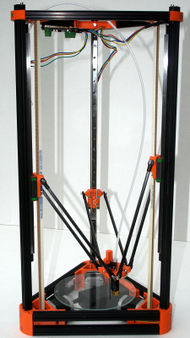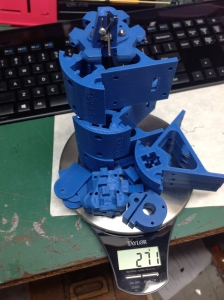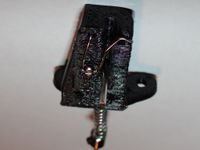Kossel
Release status: experimental
Kossel is a parametric delta robot 3D printer, built in 2012 by Johann in Seattle, USA, based on his Rostock prototype.
It is named after Albrecht Kossel, German biochemist and pioneer in the study of genetics. He was awarded the Nobel Prize for Physiology or Medicine in 1910 for his work in determining the chemical composition of nucleic acids, the genetic substance of biological cells.
History
There are several printers in the Kossel family.
Legacy Kossel
- Spectra line instead of timing belt.
- 623 bearings running directly on vertical 15 x 15 mm aluminum extrusion like OpenBeam, 6 bearings per carriage.
- PG35L extruder directly on the end effector (moving platform).
- This design is deprecated but the source files are still available.
OpenBeam Kossel Pro
- Terence Tam's design for mass manufacturing.
- Successfully funded on Kickstarter.
- Stamped and injection molded parts instead of 3D printed.
Mini Kossel
- This is Johann's latest and stable version.
- The rest of this page describes the details of Mini Kossel.
Design Goals
- Zero backlash.
- type: Delta printer
- Speed: 320 mm/s in all 3 directions.
- Resolution: 100 steps/mm in all 3 directions.
- Repeatability: better than 0.03 mm (30 micron)
- Build volume: cylindrical, 170mm diameter, 240mm height.
- Footprint: triangle, 300 mm width (240mm OpenBeam + printed corners).
- Frame height: 600 mm.
- Print surface: unheated round glass, doesn't move.
- Mass of end effector with hotend: less than 50 grams.
- Simplicity: fewer than 200 parts.
- Hardware cost: less than $600 USD.
- Fully automatic print surface level calibration (autoleveling).
Optionally scale down to a Traveling RepRap that fits within IATA hand luggage size limit (see transportation):
- Frame height: 550 mm.
- Footprint: triangle, 270 mm width, 250 mm across (210mm 15 x 15 mm aluminum extrusion like OpenBeam + printed corners).
Bill of Materials
Printed parts
- 1x plate_1x.stl which includes the following parts:
- 1x End effector
- 1x Extruder
- 1x Retractable Z probe
- 2x Power supply bracket (optional)
- 3x plate_3x.stl which includes the following parts:
- 3x Bottom vertex
- 3x Top vertex
- 3x Vertical carriage
- 6x Endstop holder
- 3x Print surface holder
Recommended print settings:
- Layer height = 0.2 to 0.3 mm (around 60% of your nozzle size)
- Perimeters = 3
- Top/bottom solid layers = 3
- Infill density = 50%
Frame
- 3x 600mm vertical OpenBeam or Misumi HFS3-1515
- 9x 240mm horizontal OpenBeam or Misumi HFS3-1515
- 1x 170mm round glass/borosilicate plate Trinity Labs or TriDPrinting.com or Makea3dfactory.com
Fasteners
- 100x M3x8mm stainless steel screws (frame and most connections)
- 100x M3 stainless steel nuts
- 100x M3 nyloc nuts
- 6x M3x20mm stainless steel screws (arm attachment to vertical carriage)
- 12x M3x25mm stainless steel screws (belt idlers and effector-rod attachments)
- 6x M3x35mm stainless steel screws (tensioners)
- 50x M3x6mm stainless steel screws (rail attachment to extrusions - 8mm is too long!)
- 12x M3x16mm stainless steel screws (push rod attachment)
- 6x M2.5x12mm screws (micro switches)
- 3x M2.5x16mm (automatic bed leveling probe)
A nuts, bolts and screws kit is available from TriDPrinting.com.
note: The 100 counts are exact, not box qty. If you desire spares.
Linear motion
- 3x 400mm hardened steel rail and carriages HIWIN MGN-12H
- 3x 1164mm GT2 belt closed loop with 2mm pitch and 6mm width
- 6x F623ZZ flanged bearings 3x10x4mm (or F684ZZ 4x9x4mm for printed parts before June 21st)
- 3x GT2 pulley with 16 teeth and 2mm pitch
- 3x Kysan NEMA17 stepper motor
Diagonal push rods
- 12x Traxxas 5347 rod ends
- 12x M4x20mm set screws
- 6x 180mm Carbon tube ID=4mm
Bowden
- 1x Clear PFA tubing ID=2mm OD=4mm
- 2x Push fit connector ID=4mm with M5 thread (or bigger thread before June 21st).
Motor
- 1x NEMA-17 motor with an integrated Planetary gearbox with a 5 2/11 :1 ratio.(http://robot-italy.com) (http://www.phidgets.com/products.php?product_id=3317 in US).
- 1x Spur Gear, 22 Tooth, 12mm od, 8mm id - #S10T05M022S0508 from SDP-SI.
- 3x M3-0.5x25 Cap Screw
- 3x M3 Washer
Idler
- 1x 625 ball bearing (5x16x5)
- 1x M5-0.8x20 Cap Screw
- 1x M5 Washer
- 1x M5-0.8 Hex Nut (Nylock optional)
- 1x M3-0.5x16 Cap Screw
- 1x M3 Washer
- 1x M3-0.5 Hex Nut, Nylock
Endstops
Automatic bed leveling probe
- 1x Micro switch (same as for endstops above)
- 1x Bondhus 1.5mm allen wrench
- 1x Safety pin with 2.5mm loop
- 2x Ball point pen spring
- 1x Euro-style terminal block connector
- 1x Heat shrink tubing ID=2mm
Electronics
- 1x Baboi or Azteeg_X3 or RAMPS_1.4 or Printrboard or Brainwave other electronics.
- 1x 12V 5A LCD screen power supply
Assembly instructions
Step By Step Instructions
For step by step instructions see the following website http://www.builda3dprinter.eu
Step by step instructions for Kossel Mini kits from Blomker Industries
Blomker Kossel Mini Kit Assembly Guide
Autolevel probe
X_MAX, Y_MAX, Z_MAX top endstops: NC (Normally Connected). M119 for these should show:
- TRIGGERED when the carriage touches the endstop.
- open during normal operation.
Z_MIN autolevel probe: NO (Normally Open). M119 for Z_MIN should show:
- TRIGGERED when the autolevel probe is retracted (up).
- open when the autolevel probe is deployed (down).
- TRIGGERED when the autolevel probe touches the print surface.
Make sure that M119 does NOT show X_MIN or Y_MIN, if it does you must change them to -1 in Marlin/pins.h.
Viki LCD with Azteeg X3
References:
Connect Viki J2 to Azteeg EXP3 port like this:
- +5V to +5V (red)
- GND to GND (black)
- SDA to SDA (blue)
- SCL to SCL (green)
- ENC_A to D22 (white)
- ENC_B to D7 (yellow)
Connect Viki J3 to Azteeg ICSP port like this:
- CS to CHIP SELECT (D53) (red)
- BTN to D32 on EXP2 (optional) (black)
- DI to MOSI (blue)
- CLK to SCK (green)
- DO to MISO (white)
- CD to CARD DETECT (D49)(yellow)
CS (D53) and CD (D49) are directly next to the ICSP port, under the expansion shield.
BTN is for the pause/stop/resume LCD button (kill switch). We recommend not connecting it and using a power switch for emergency stop instead. If you do want to use it, it should be connected to the Arduino BTN_ENC pin. Otherwise set BTN_ENC to -1 if not used.
This uses the LiquidTWI2 library v1.2.3 or later. Copy the LiquidTWI2 directory into the Arduino libraries subdirectory (something like /Applications/Arduino.app/Contents/Resources/Java/libraries/LiquidTWI2, just next to the existing LiquidCrystal folder). If you end up with a directory named "LiquidTWI2-master" then remove the "-master" part.
If you get compile errors in Wire.h, try Arduino version 0023.
In Marlin/Configuration.h uncomment or adjust the following lines:
- #define MOTHERBOARD 33 // Azteeg X3
- #define SDSUPPORT true
- #define LCD_I2C_VIKI
In Marlin/pins.h under MOTHERBOARD == 33 adjust the following lines:
- #define SDSS 53
- #define SDCARDDETECT 49
- #define BTN_EN1 22
- #define BTN_EN2 7
- #define BTN_ENC 31
Disconnect solder jumper JP12 at bottom of Azteeg X3 to disable onboard SD slot and use pins for external SD reader (Viki LCD SD slot).
Links
- Step by Step manual to build a Kossel mini
- Project blog on Tumblr
- Pictures on Flickr
- Mailing list for questions and answers
- OpenSCAD source files on GitHub for printed plastic parts.
- Modified Marlin firmware on GitHub for delta geometry on Arduino.
- Frame size calculator spreadsheet.
- Assembly Guide for Blomker Industries Kossel Mini Kit


